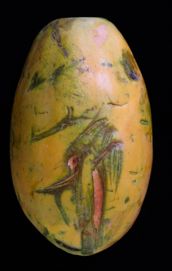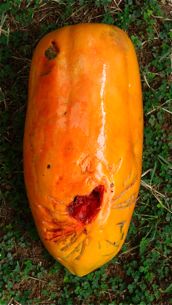The papaya trees (Carica papaya) in Tan Teo Seng’s farm in Johor, Malaysia are in fruits the year round. To enjoy the fruits, he has to be one step ahead of a family of Oriental Pied Hornbills (Anthracoceros albirostris). These birds regularly visit the trees, perching on the long leaf stalks to invariably cause them to collapse due to the birds’ weight.
Young green fruits are left alone. But when a fruit starts to turn yellow, the hornbills will check out its state of ripeness with the sharp points of their massive mandibles. In the process the birds leave characteristic markings on the yet-to-ripen fruit surface (below left).
The hornbills return daily to monitor the fruit’s ripening. And only when the fruit is fully ripe can the hornbill break into the fruit to peck off chunks of the ripened flesh. First a small opening is formed as the hornbill works its way into the flesh (above centre). This opening will widen as the sharp mandible tips steadily gouge the flesh to be swallowed with a flick of the hornbill’s head.
The fruit is never eaten in its entirety but abandoned after about a quarter is consumed (above right). The remaining fruit is left to other smaller birds like mynas, starlings, bulbuls, orioles, etc. to enjoy.
Birds generally have the best vision among the vertebrates. They also have well-developed colour vision. They have poor sense of smell as well as sense of taste. Hornbills presumably are no exception. Thus it can be assumed that they know when the papaya ripens but are unable to gauge the degree of ripeness by smell. They have to resort to testing the softness of the fruit by probing with their mandible tips.
Images by YC.












3 Responses